Western Sydney University: 401021 Nursing Case Study - Legal Issues
VerifiedAdded on 2022/09/17
|8
|1885
|16
Case Study
AI Summary
This case study examines a scenario involving an 81-year-old patient admitted to the hospital with respiratory and other health issues. The patient's condition deteriorated, highlighting issues of nursing care, communication, and adherence to professional standards. The case study delves into the nurse's responsibilities in assessing patient conditions, recognizing abnormal vital signs, and taking timely actions. It explores the importance of effective communication with other healthcare professionals, the need for critical thinking, and the implications of professional errors. The analysis emphasizes the nurse's failure to adhere to nursing standards, leading to the patient's death, and discusses the contributory factors, implications for future practice, and the importance of competence, knowledge, and adherence to ethical guidelines in providing quality patient care. The assignment also highlights the hospital's breach of professional standards and the necessity of a multidisciplinary approach to ensure patient safety and improved health outcomes. The case study concludes with a discussion of the importance of nurses' adequate knowledge, skills, and timely interventions in preventing adverse outcomes and ensuring patient well-being.
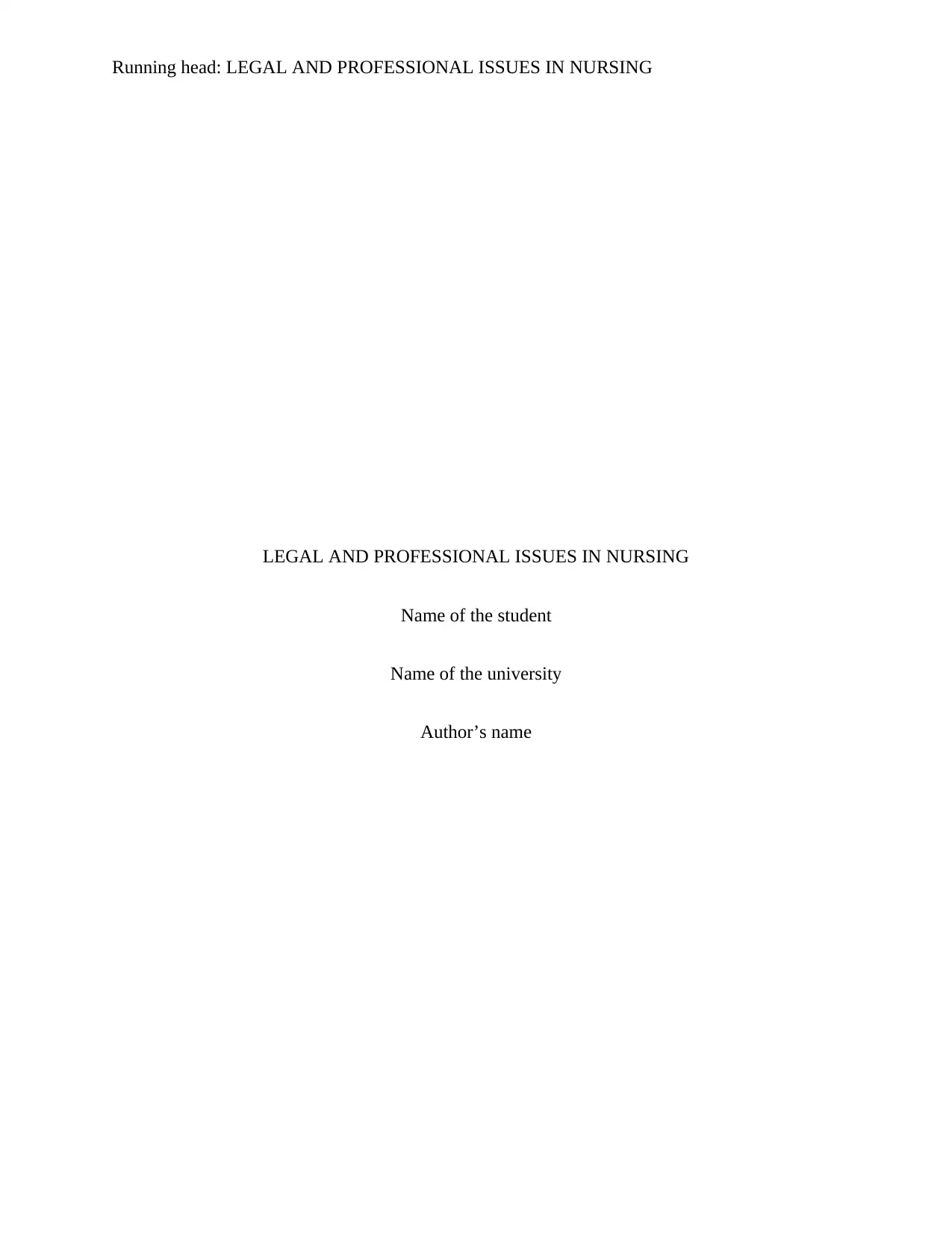
Running head: LEGAL AND PROFESSIONAL ISSUES IN NURSING
LEGAL AND PROFESSIONAL ISSUES IN NURSING
Name of the student
Name of the university
Author’s name
LEGAL AND PROFESSIONAL ISSUES IN NURSING
Name of the student
Name of the university
Author’s name
Paraphrase This Document
Need a fresh take? Get an instant paraphrase of this document with our AI Paraphraser
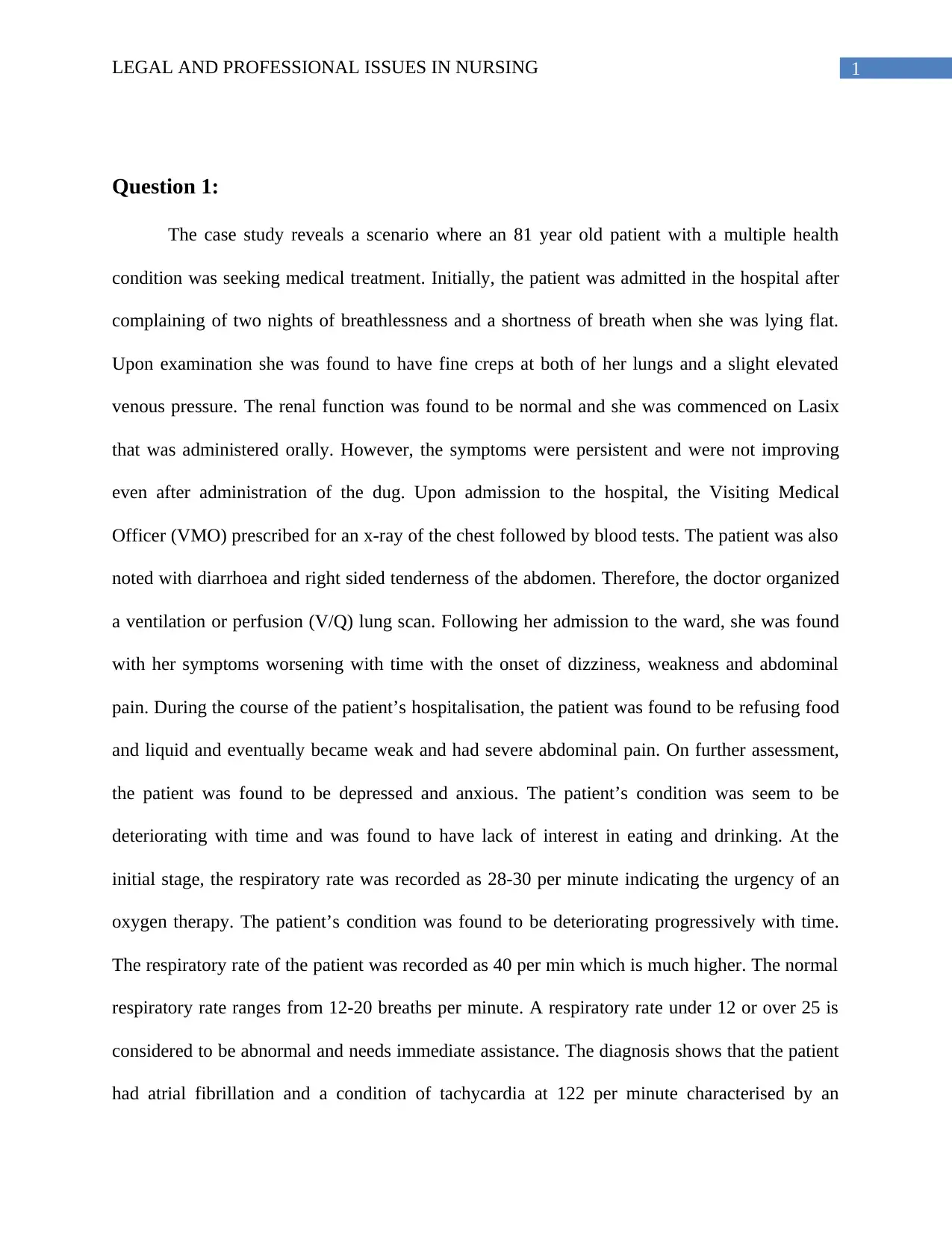
1LEGAL AND PROFESSIONAL ISSUES IN NURSING
Question 1:
The case study reveals a scenario where an 81 year old patient with a multiple health
condition was seeking medical treatment. Initially, the patient was admitted in the hospital after
complaining of two nights of breathlessness and a shortness of breath when she was lying flat.
Upon examination she was found to have fine creps at both of her lungs and a slight elevated
venous pressure. The renal function was found to be normal and she was commenced on Lasix
that was administered orally. However, the symptoms were persistent and were not improving
even after administration of the dug. Upon admission to the hospital, the Visiting Medical
Officer (VMO) prescribed for an x-ray of the chest followed by blood tests. The patient was also
noted with diarrhoea and right sided tenderness of the abdomen. Therefore, the doctor organized
a ventilation or perfusion (V/Q) lung scan. Following her admission to the ward, she was found
with her symptoms worsening with time with the onset of dizziness, weakness and abdominal
pain. During the course of the patient’s hospitalisation, the patient was found to be refusing food
and liquid and eventually became weak and had severe abdominal pain. On further assessment,
the patient was found to be depressed and anxious. The patient’s condition was seem to be
deteriorating with time and was found to have lack of interest in eating and drinking. At the
initial stage, the respiratory rate was recorded as 28-30 per minute indicating the urgency of an
oxygen therapy. The patient’s condition was found to be deteriorating progressively with time.
The respiratory rate of the patient was recorded as 40 per min which is much higher. The normal
respiratory rate ranges from 12-20 breaths per minute. A respiratory rate under 12 or over 25 is
considered to be abnormal and needs immediate assistance. The diagnosis shows that the patient
had atrial fibrillation and a condition of tachycardia at 122 per minute characterised by an
Question 1:
The case study reveals a scenario where an 81 year old patient with a multiple health
condition was seeking medical treatment. Initially, the patient was admitted in the hospital after
complaining of two nights of breathlessness and a shortness of breath when she was lying flat.
Upon examination she was found to have fine creps at both of her lungs and a slight elevated
venous pressure. The renal function was found to be normal and she was commenced on Lasix
that was administered orally. However, the symptoms were persistent and were not improving
even after administration of the dug. Upon admission to the hospital, the Visiting Medical
Officer (VMO) prescribed for an x-ray of the chest followed by blood tests. The patient was also
noted with diarrhoea and right sided tenderness of the abdomen. Therefore, the doctor organized
a ventilation or perfusion (V/Q) lung scan. Following her admission to the ward, she was found
with her symptoms worsening with time with the onset of dizziness, weakness and abdominal
pain. During the course of the patient’s hospitalisation, the patient was found to be refusing food
and liquid and eventually became weak and had severe abdominal pain. On further assessment,
the patient was found to be depressed and anxious. The patient’s condition was seem to be
deteriorating with time and was found to have lack of interest in eating and drinking. At the
initial stage, the respiratory rate was recorded as 28-30 per minute indicating the urgency of an
oxygen therapy. The patient’s condition was found to be deteriorating progressively with time.
The respiratory rate of the patient was recorded as 40 per min which is much higher. The normal
respiratory rate ranges from 12-20 breaths per minute. A respiratory rate under 12 or over 25 is
considered to be abnormal and needs immediate assistance. The diagnosis shows that the patient
had atrial fibrillation and a condition of tachycardia at 122 per minute characterised by an
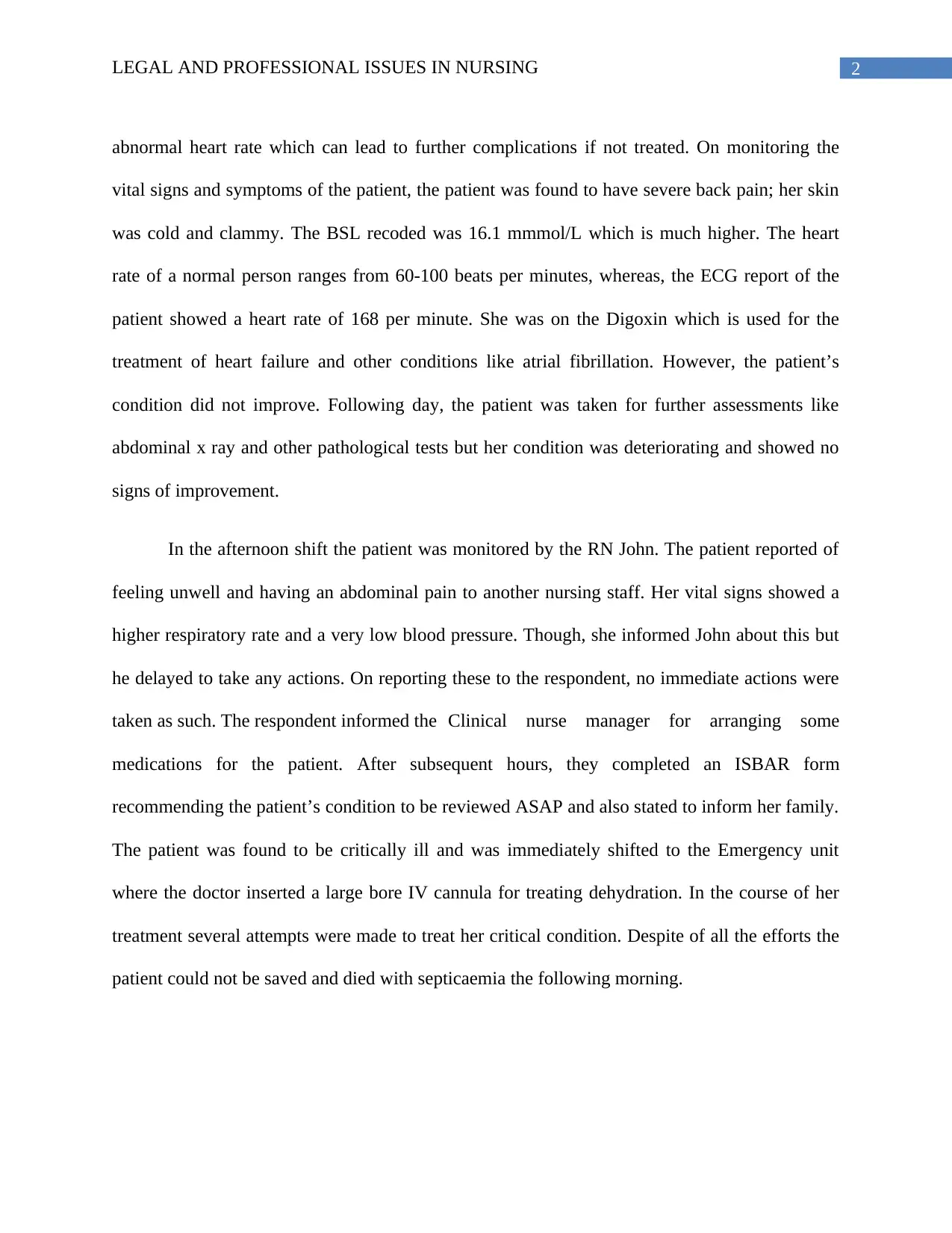
2LEGAL AND PROFESSIONAL ISSUES IN NURSING
abnormal heart rate which can lead to further complications if not treated. On monitoring the
vital signs and symptoms of the patient, the patient was found to have severe back pain; her skin
was cold and clammy. The BSL recoded was 16.1 mmmol/L which is much higher. The heart
rate of a normal person ranges from 60-100 beats per minutes, whereas, the ECG report of the
patient showed a heart rate of 168 per minute. She was on the Digoxin which is used for the
treatment of heart failure and other conditions like atrial fibrillation. However, the patient’s
condition did not improve. Following day, the patient was taken for further assessments like
abdominal x ray and other pathological tests but her condition was deteriorating and showed no
signs of improvement.
In the afternoon shift the patient was monitored by the RN John. The patient reported of
feeling unwell and having an abdominal pain to another nursing staff. Her vital signs showed a
higher respiratory rate and a very low blood pressure. Though, she informed John about this but
he delayed to take any actions. On reporting these to the respondent, no immediate actions were
taken as such. The respondent informed the Clinical nurse manager for arranging some
medications for the patient. After subsequent hours, they completed an ISBAR form
recommending the patient’s condition to be reviewed ASAP and also stated to inform her family.
The patient was found to be critically ill and was immediately shifted to the Emergency unit
where the doctor inserted a large bore IV cannula for treating dehydration. In the course of her
treatment several attempts were made to treat her critical condition. Despite of all the efforts the
patient could not be saved and died with septicaemia the following morning.
abnormal heart rate which can lead to further complications if not treated. On monitoring the
vital signs and symptoms of the patient, the patient was found to have severe back pain; her skin
was cold and clammy. The BSL recoded was 16.1 mmmol/L which is much higher. The heart
rate of a normal person ranges from 60-100 beats per minutes, whereas, the ECG report of the
patient showed a heart rate of 168 per minute. She was on the Digoxin which is used for the
treatment of heart failure and other conditions like atrial fibrillation. However, the patient’s
condition did not improve. Following day, the patient was taken for further assessments like
abdominal x ray and other pathological tests but her condition was deteriorating and showed no
signs of improvement.
In the afternoon shift the patient was monitored by the RN John. The patient reported of
feeling unwell and having an abdominal pain to another nursing staff. Her vital signs showed a
higher respiratory rate and a very low blood pressure. Though, she informed John about this but
he delayed to take any actions. On reporting these to the respondent, no immediate actions were
taken as such. The respondent informed the Clinical nurse manager for arranging some
medications for the patient. After subsequent hours, they completed an ISBAR form
recommending the patient’s condition to be reviewed ASAP and also stated to inform her family.
The patient was found to be critically ill and was immediately shifted to the Emergency unit
where the doctor inserted a large bore IV cannula for treating dehydration. In the course of her
treatment several attempts were made to treat her critical condition. Despite of all the efforts the
patient could not be saved and died with septicaemia the following morning.
⊘ This is a preview!⊘
Do you want full access?
Subscribe today to unlock all pages.

Trusted by 1+ million students worldwide
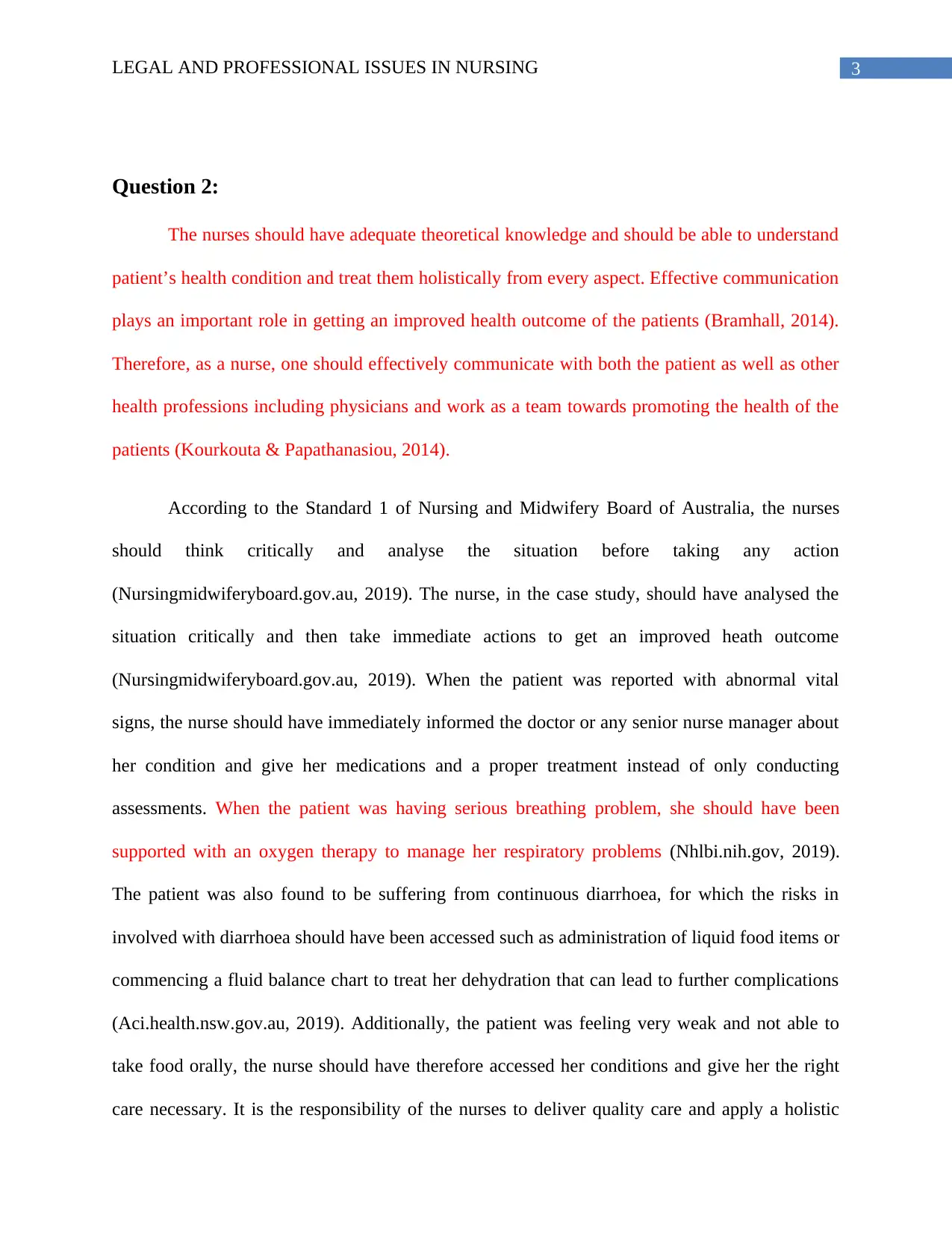
3LEGAL AND PROFESSIONAL ISSUES IN NURSING
Question 2:
The nurses should have adequate theoretical knowledge and should be able to understand
patient’s health condition and treat them holistically from every aspect. Effective communication
plays an important role in getting an improved health outcome of the patients (Bramhall, 2014).
Therefore, as a nurse, one should effectively communicate with both the patient as well as other
health professions including physicians and work as a team towards promoting the health of the
patients (Kourkouta & Papathanasiou, 2014).
According to the Standard 1 of Nursing and Midwifery Board of Australia, the nurses
should think critically and analyse the situation before taking any action
(Nursingmidwiferyboard.gov.au, 2019). The nurse, in the case study, should have analysed the
situation critically and then take immediate actions to get an improved heath outcome
(Nursingmidwiferyboard.gov.au, 2019). When the patient was reported with abnormal vital
signs, the nurse should have immediately informed the doctor or any senior nurse manager about
her condition and give her medications and a proper treatment instead of only conducting
assessments. When the patient was having serious breathing problem, she should have been
supported with an oxygen therapy to manage her respiratory problems (Nhlbi.nih.gov, 2019).
The patient was also found to be suffering from continuous diarrhoea, for which the risks in
involved with diarrhoea should have been accessed such as administration of liquid food items or
commencing a fluid balance chart to treat her dehydration that can lead to further complications
(Aci.health.nsw.gov.au, 2019). Additionally, the patient was feeling very weak and not able to
take food orally, the nurse should have therefore accessed her conditions and give her the right
care necessary. It is the responsibility of the nurses to deliver quality care and apply a holistic
Question 2:
The nurses should have adequate theoretical knowledge and should be able to understand
patient’s health condition and treat them holistically from every aspect. Effective communication
plays an important role in getting an improved health outcome of the patients (Bramhall, 2014).
Therefore, as a nurse, one should effectively communicate with both the patient as well as other
health professions including physicians and work as a team towards promoting the health of the
patients (Kourkouta & Papathanasiou, 2014).
According to the Standard 1 of Nursing and Midwifery Board of Australia, the nurses
should think critically and analyse the situation before taking any action
(Nursingmidwiferyboard.gov.au, 2019). The nurse, in the case study, should have analysed the
situation critically and then take immediate actions to get an improved heath outcome
(Nursingmidwiferyboard.gov.au, 2019). When the patient was reported with abnormal vital
signs, the nurse should have immediately informed the doctor or any senior nurse manager about
her condition and give her medications and a proper treatment instead of only conducting
assessments. When the patient was having serious breathing problem, she should have been
supported with an oxygen therapy to manage her respiratory problems (Nhlbi.nih.gov, 2019).
The patient was also found to be suffering from continuous diarrhoea, for which the risks in
involved with diarrhoea should have been accessed such as administration of liquid food items or
commencing a fluid balance chart to treat her dehydration that can lead to further complications
(Aci.health.nsw.gov.au, 2019). Additionally, the patient was feeling very weak and not able to
take food orally, the nurse should have therefore accessed her conditions and give her the right
care necessary. It is the responsibility of the nurses to deliver quality care and apply a holistic
Paraphrase This Document
Need a fresh take? Get an instant paraphrase of this document with our AI Paraphraser
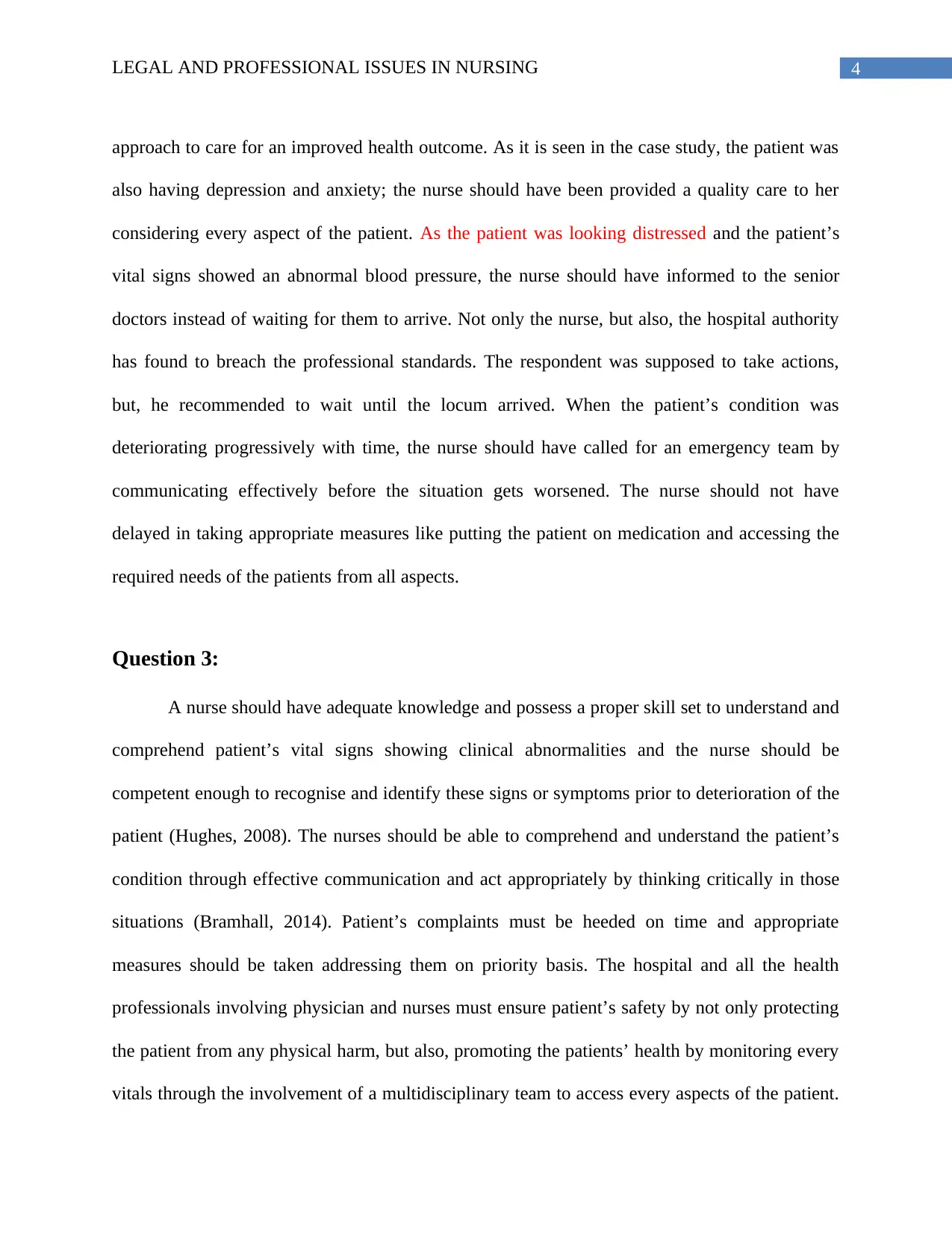
4LEGAL AND PROFESSIONAL ISSUES IN NURSING
approach to care for an improved health outcome. As it is seen in the case study, the patient was
also having depression and anxiety; the nurse should have been provided a quality care to her
considering every aspect of the patient. As the patient was looking distressed and the patient’s
vital signs showed an abnormal blood pressure, the nurse should have informed to the senior
doctors instead of waiting for them to arrive. Not only the nurse, but also, the hospital authority
has found to breach the professional standards. The respondent was supposed to take actions,
but, he recommended to wait until the locum arrived. When the patient’s condition was
deteriorating progressively with time, the nurse should have called for an emergency team by
communicating effectively before the situation gets worsened. The nurse should not have
delayed in taking appropriate measures like putting the patient on medication and accessing the
required needs of the patients from all aspects.
Question 3:
A nurse should have adequate knowledge and possess a proper skill set to understand and
comprehend patient’s vital signs showing clinical abnormalities and the nurse should be
competent enough to recognise and identify these signs or symptoms prior to deterioration of the
patient (Hughes, 2008). The nurses should be able to comprehend and understand the patient’s
condition through effective communication and act appropriately by thinking critically in those
situations (Bramhall, 2014). Patient’s complaints must be heeded on time and appropriate
measures should be taken addressing them on priority basis. The hospital and all the health
professionals involving physician and nurses must ensure patient’s safety by not only protecting
the patient from any physical harm, but also, promoting the patients’ health by monitoring every
vitals through the involvement of a multidisciplinary team to access every aspects of the patient.
approach to care for an improved health outcome. As it is seen in the case study, the patient was
also having depression and anxiety; the nurse should have been provided a quality care to her
considering every aspect of the patient. As the patient was looking distressed and the patient’s
vital signs showed an abnormal blood pressure, the nurse should have informed to the senior
doctors instead of waiting for them to arrive. Not only the nurse, but also, the hospital authority
has found to breach the professional standards. The respondent was supposed to take actions,
but, he recommended to wait until the locum arrived. When the patient’s condition was
deteriorating progressively with time, the nurse should have called for an emergency team by
communicating effectively before the situation gets worsened. The nurse should not have
delayed in taking appropriate measures like putting the patient on medication and accessing the
required needs of the patients from all aspects.
Question 3:
A nurse should have adequate knowledge and possess a proper skill set to understand and
comprehend patient’s vital signs showing clinical abnormalities and the nurse should be
competent enough to recognise and identify these signs or symptoms prior to deterioration of the
patient (Hughes, 2008). The nurses should be able to comprehend and understand the patient’s
condition through effective communication and act appropriately by thinking critically in those
situations (Bramhall, 2014). Patient’s complaints must be heeded on time and appropriate
measures should be taken addressing them on priority basis. The hospital and all the health
professionals involving physician and nurses must ensure patient’s safety by not only protecting
the patient from any physical harm, but also, promoting the patients’ health by monitoring every
vitals through the involvement of a multidisciplinary team to access every aspects of the patient.
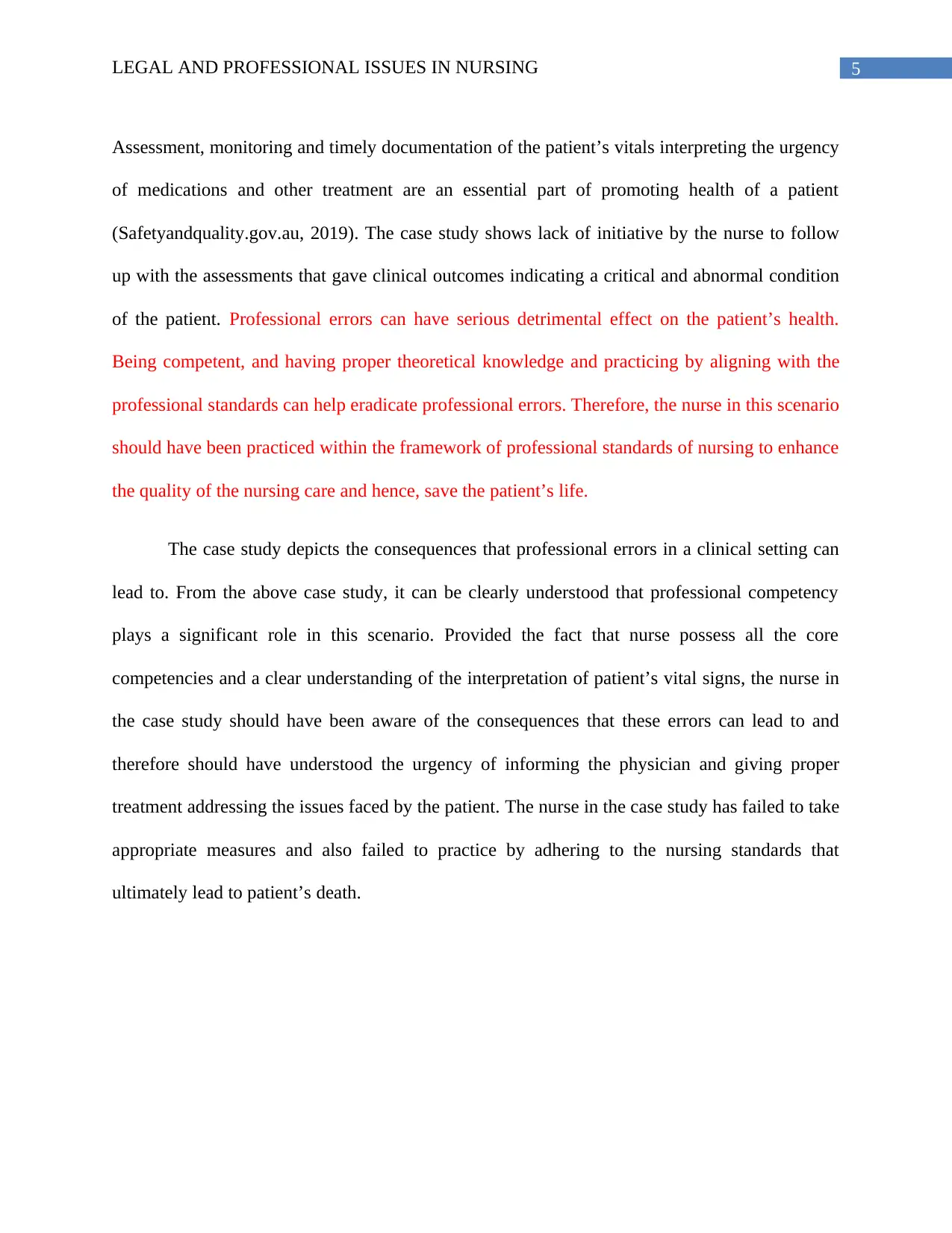
5LEGAL AND PROFESSIONAL ISSUES IN NURSING
Assessment, monitoring and timely documentation of the patient’s vitals interpreting the urgency
of medications and other treatment are an essential part of promoting health of a patient
(Safetyandquality.gov.au, 2019). The case study shows lack of initiative by the nurse to follow
up with the assessments that gave clinical outcomes indicating a critical and abnormal condition
of the patient. Professional errors can have serious detrimental effect on the patient’s health.
Being competent, and having proper theoretical knowledge and practicing by aligning with the
professional standards can help eradicate professional errors. Therefore, the nurse in this scenario
should have been practiced within the framework of professional standards of nursing to enhance
the quality of the nursing care and hence, save the patient’s life.
The case study depicts the consequences that professional errors in a clinical setting can
lead to. From the above case study, it can be clearly understood that professional competency
plays a significant role in this scenario. Provided the fact that nurse possess all the core
competencies and a clear understanding of the interpretation of patient’s vital signs, the nurse in
the case study should have been aware of the consequences that these errors can lead to and
therefore should have understood the urgency of informing the physician and giving proper
treatment addressing the issues faced by the patient. The nurse in the case study has failed to take
appropriate measures and also failed to practice by adhering to the nursing standards that
ultimately lead to patient’s death.
Assessment, monitoring and timely documentation of the patient’s vitals interpreting the urgency
of medications and other treatment are an essential part of promoting health of a patient
(Safetyandquality.gov.au, 2019). The case study shows lack of initiative by the nurse to follow
up with the assessments that gave clinical outcomes indicating a critical and abnormal condition
of the patient. Professional errors can have serious detrimental effect on the patient’s health.
Being competent, and having proper theoretical knowledge and practicing by aligning with the
professional standards can help eradicate professional errors. Therefore, the nurse in this scenario
should have been practiced within the framework of professional standards of nursing to enhance
the quality of the nursing care and hence, save the patient’s life.
The case study depicts the consequences that professional errors in a clinical setting can
lead to. From the above case study, it can be clearly understood that professional competency
plays a significant role in this scenario. Provided the fact that nurse possess all the core
competencies and a clear understanding of the interpretation of patient’s vital signs, the nurse in
the case study should have been aware of the consequences that these errors can lead to and
therefore should have understood the urgency of informing the physician and giving proper
treatment addressing the issues faced by the patient. The nurse in the case study has failed to take
appropriate measures and also failed to practice by adhering to the nursing standards that
ultimately lead to patient’s death.
⊘ This is a preview!⊘
Do you want full access?
Subscribe today to unlock all pages.

Trusted by 1+ million students worldwide
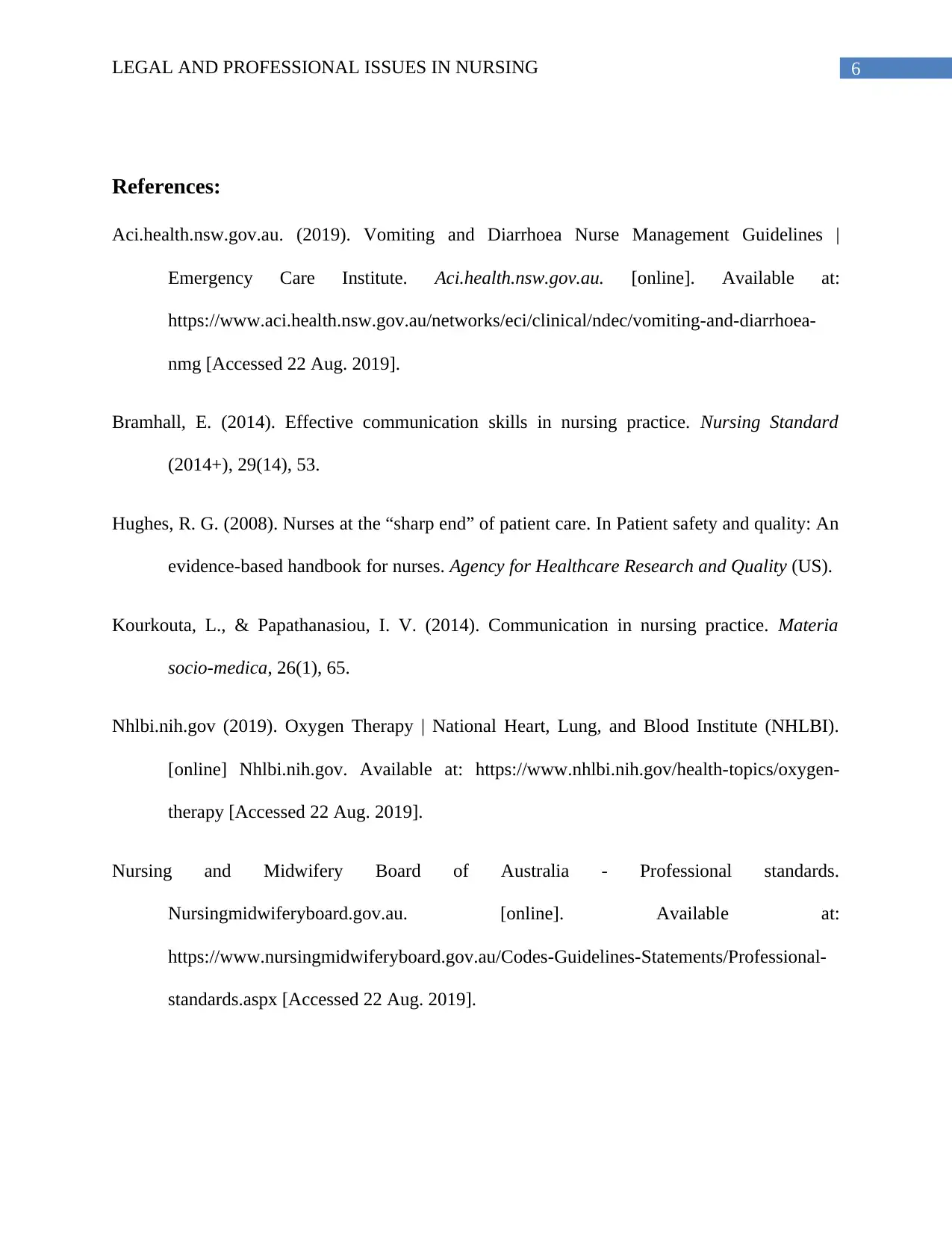
6LEGAL AND PROFESSIONAL ISSUES IN NURSING
References:
Aci.health.nsw.gov.au. (2019). Vomiting and Diarrhoea Nurse Management Guidelines |
Emergency Care Institute. Aci.health.nsw.gov.au. [online]. Available at:
https://www.aci.health.nsw.gov.au/networks/eci/clinical/ndec/vomiting-and-diarrhoea-
nmg [Accessed 22 Aug. 2019].
Bramhall, E. (2014). Effective communication skills in nursing practice. Nursing Standard
(2014+), 29(14), 53.
Hughes, R. G. (2008). Nurses at the “sharp end” of patient care. In Patient safety and quality: An
evidence-based handbook for nurses. Agency for Healthcare Research and Quality (US).
Kourkouta, L., & Papathanasiou, I. V. (2014). Communication in nursing practice. Materia
socio-medica, 26(1), 65.
Nhlbi.nih.gov (2019). Oxygen Therapy | National Heart, Lung, and Blood Institute (NHLBI).
[online] Nhlbi.nih.gov. Available at: https://www.nhlbi.nih.gov/health-topics/oxygen-
therapy [Accessed 22 Aug. 2019].
Nursing and Midwifery Board of Australia - Professional standards.
Nursingmidwiferyboard.gov.au. [online]. Available at:
https://www.nursingmidwiferyboard.gov.au/Codes-Guidelines-Statements/Professional-
standards.aspx [Accessed 22 Aug. 2019].
References:
Aci.health.nsw.gov.au. (2019). Vomiting and Diarrhoea Nurse Management Guidelines |
Emergency Care Institute. Aci.health.nsw.gov.au. [online]. Available at:
https://www.aci.health.nsw.gov.au/networks/eci/clinical/ndec/vomiting-and-diarrhoea-
nmg [Accessed 22 Aug. 2019].
Bramhall, E. (2014). Effective communication skills in nursing practice. Nursing Standard
(2014+), 29(14), 53.
Hughes, R. G. (2008). Nurses at the “sharp end” of patient care. In Patient safety and quality: An
evidence-based handbook for nurses. Agency for Healthcare Research and Quality (US).
Kourkouta, L., & Papathanasiou, I. V. (2014). Communication in nursing practice. Materia
socio-medica, 26(1), 65.
Nhlbi.nih.gov (2019). Oxygen Therapy | National Heart, Lung, and Blood Institute (NHLBI).
[online] Nhlbi.nih.gov. Available at: https://www.nhlbi.nih.gov/health-topics/oxygen-
therapy [Accessed 22 Aug. 2019].
Nursing and Midwifery Board of Australia - Professional standards.
Nursingmidwiferyboard.gov.au. [online]. Available at:
https://www.nursingmidwiferyboard.gov.au/Codes-Guidelines-Statements/Professional-
standards.aspx [Accessed 22 Aug. 2019].
Paraphrase This Document
Need a fresh take? Get an instant paraphrase of this document with our AI Paraphraser
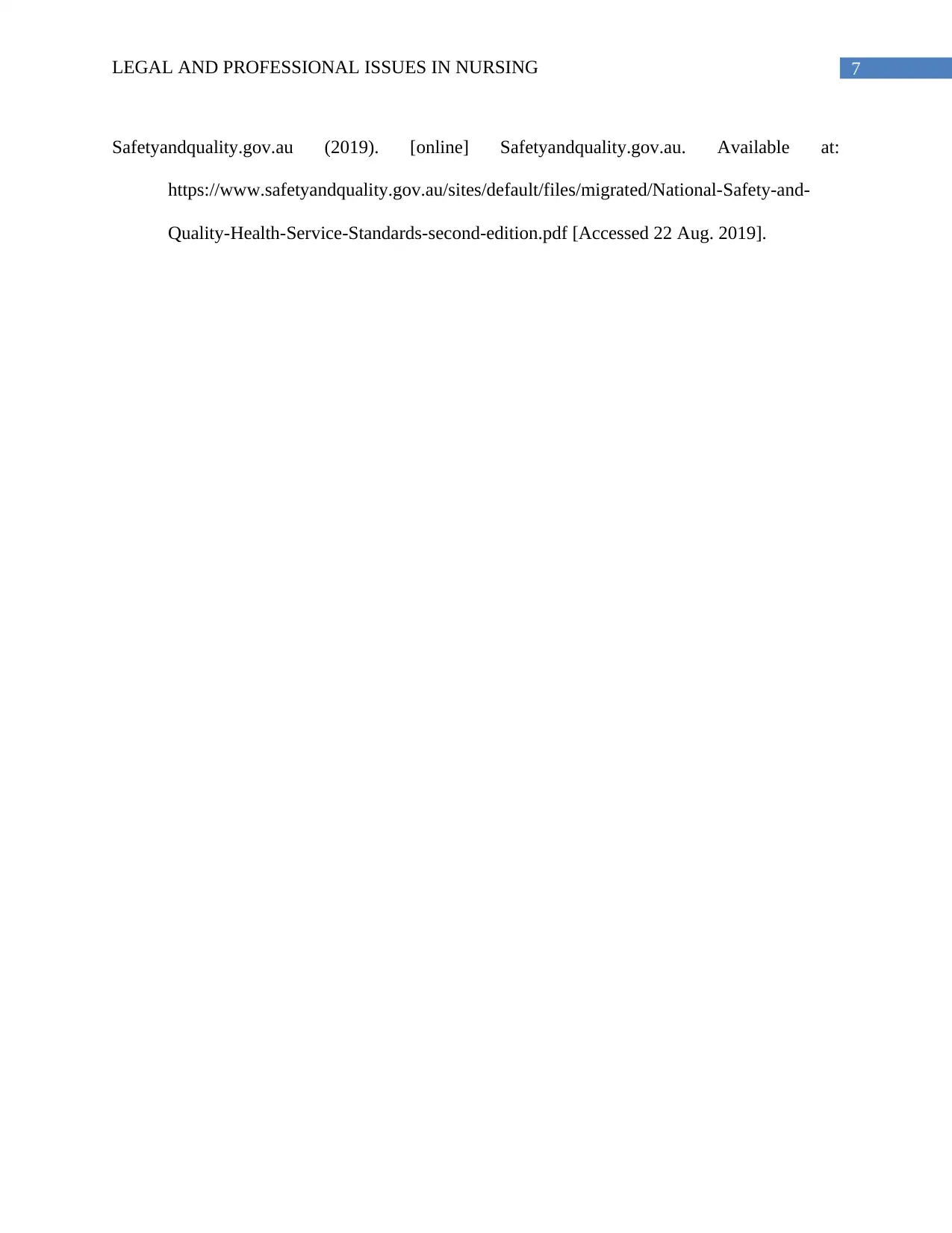
7LEGAL AND PROFESSIONAL ISSUES IN NURSING
Safetyandquality.gov.au (2019). [online] Safetyandquality.gov.au. Available at:
https://www.safetyandquality.gov.au/sites/default/files/migrated/National-Safety-and-
Quality-Health-Service-Standards-second-edition.pdf [Accessed 22 Aug. 2019].
Safetyandquality.gov.au (2019). [online] Safetyandquality.gov.au. Available at:
https://www.safetyandquality.gov.au/sites/default/files/migrated/National-Safety-and-
Quality-Health-Service-Standards-second-edition.pdf [Accessed 22 Aug. 2019].
1 out of 8
Related Documents
Your All-in-One AI-Powered Toolkit for Academic Success.
+13062052269
info@desklib.com
Available 24*7 on WhatsApp / Email
![[object Object]](/_next/static/media/star-bottom.7253800d.svg)
Unlock your academic potential
Copyright © 2020–2025 A2Z Services. All Rights Reserved. Developed and managed by ZUCOL.





